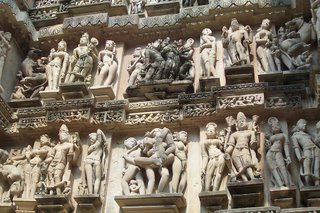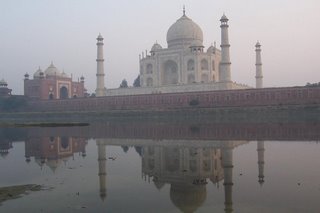Before leaving Varanasi, we made a brief stop at Saranath, an important Buddhist pilgrimage site. It is the place where Siddhartha Gotama, the first Buddha, gave his teachings describing the four noble truths and the basic tenets of Buddhism. For this reason, it was also once the site of an impressive temple complex. However, there is scant evidence of this now. These days, the most remarkable thing about Saranath is the long and very intense staring we are subjected to by the masses of middle-class Indian families that picnic here on the grassy lawns.
Don't get me wrong, I'm all for a bit of staring. We look different, we speak different, we come from a different place. For the most part, I can relate to their curious- trying to gather their courage to talk with us. However, Indians take staring to a whole new level.
On a recent bus ride, a man sitting in a seat in front of us turned around, rested his head on his cushion and stared at me, without pause, for ten minutes straight. I tried to stare back at him, but found it impossible to hold his gaze. I swear, he didn't so much as blink ! Most irritating are small packs of middle-class Indian teenage boys who find following a couple of white tourists around a park and staring at them to be a day filling activity so immensely fascinating it warrants repeated photography. Katlijn is a particularly popular target. Even after asking the boys not to photograph her, they'll hide behind pillars and bushes, snapping her picture paparazzi style.
ATTENTION INDIANS:
If you are reading this blog, please leave me a comment below answering the following question: what on earth do you do with photographs of random white tourists !? Honestly, we have no idea.
The troubling thing is that most Indians know about as much about the West as we know about India, which is to say, pretty much nothing at all. For example, we once met an Indian on the train who was shocked that we stayed at cheap hotel rooms, did not travel first class, and used an unfashionably low budget cell phone. His impression of foreigners is that we just give money away freely to anyone who asks because we have so much of it. More insulting: our understanding is that many Indian males still think white women are sex-craved targets willing to have pre-marital escapades with any Indian man- an attitude which is clearly reinforced by much of the popular Indian media. We are very often asked about our marital status and, on the rare occasions we tell Nepali and Indian people that we are not married, they tend to shake their head and nudge each other as if confirming their basest pre-conceptions. The problem then with staring, is not so much the staring, it is thinking about what the other person is thinking about- pitting one set of misconceptions against the other.
The only other remarkable thing about Saranath are the locals attempting to "line up" for tickets. There is no actual line, but a massive tangle of bodies elbowing, shoving, and pressing up against each other. At the ticket gate, hundreds of hands can be seen holding onto the booth's bars, white knuckled, pulling the rest of their bodies to the front of the horde. There are so many bodies pressed so tightly against one another that it no longer resembles a crowd of individuals, but one single multi-headed, multi-limbed monster surging up against a poor emaciated ticket wallah cowering inside a ramshackle booth, locked in a life or death struggle with the beast, desperately trying to stave off its many thrashing appendages with nothing more than tiny stubs of paper. Interestingly, women are actually allowed to go, automatically, to the front of the queue-beast. Of course, I have never met a western woman willing to test this theory given the monster's many groping hands and its multiplicity of male brains.
We escaped the monstrous, staring crowd in the early evening to arrive at Varanasi's train station. At night, Indian train stations look like refugee camps full of hundreds of weary Indians sleeping on the concrete ground waiting for their train to arrive. In our experience, nothing ever seems to work as expected in India, so we were positively astounded to find our names listed properly on the side of the correct train car. How could it be that our information was sent from an Internet form to some remote Indian operator, having filtered through the creaking Indian train system bureaucracy (presumably oiled by countless 5 rupee basksheesh) to arrive at the Varanasi station manger who paid off some tout to paste it on the side of a train so it was hanging right in front of us ? And this is not an isolated event ! Our names are always there: spelled correctly and pasted firmly on the side of the correct train car. How all these multitudinous transactions occur without problem, while I can't even get hotel owners to bring me a bucket of hot water, is truly one of the great mysteries of India.
Indian trains have about 6-8 classes to accommodate the budget and comfort requirements of all travelers. We are budget travelers and therefore ride in the "sleeper class" which is the second lowest class (even we don't travel with the lowest class which is a kind of repository of all the worst rumours you have ever heard about India). Trying to overcome the snoring passengers around me, I stuffed my imitation Sony earphones from Nepal deep into my ears for a bit of music. However, no matter how hard I pushed, the right ear piece produced nothing more than an annoying buzzing, while the left one gave only a distant hum. Whenever something like this happens, Katlijn likes to make the following remark: "junk country !" which succinctly summarizes the quality of the merchandise we have purchased since landing in Nepal. Without functional earphones, I took a few sleeping pills and let the gentle motion of the train rock me to sleep.
We began our post-Varanasi, post-queue-beast encounter by visiting the erotic temples of Kajuraho. These temples were the result of a mysterious creative burst occurring between 950-1050 AD by the Chandelan people, one of the last early Hindu empires in North India. Nobody knows why they bothered to make such an extensive temple complex in a place with absolutely no strategic value at all. I can tell you from our long overnight train-ride and subsequent 6 hour bus experience that it truly is in the middle of nowhere. If not for the temples, the small band of locals who man this outpost attraction would never be here. They constantly complain about the lack of rainfall and are more reluctant than usual to provide us a bucket of hot water- it hasn't rained here for three years !

 
Most tour books erroneously refer to the Kajuraho temples as "erotic" temples. Admittedly, a few of the thousands of fine sculptures that cover these temples are of rather shocking threesomes and foursomes. However, the vast majority simply depict women in daily life. The reason for sculpting such lurid scenes and the artists' original intent in general remains a mystery to Indo-Aryan scholars.
Shortly after the completion of the Kajuraho temples, they were abandoned for the nearby forts to help ward off the various groups of Muslims invading from Afghanistan. This was the beginning of centuries of Hindu-Muslim conflicts which continue to this day in various forms, including present tensions along the Pakistan-India border. It would be another 800 years before the temples were accidentally rediscovered by a lost British colonist. We spent a couple of very happy days biking around the temple grounds, absorbing the beautiful architecture and exquisite carvings- definitely the most impressive we have seen in all of India.
We continued on to a city called Orcha where we met up with Party-Dean, the Aussie backpacker, and the German couple, Karsten and his wife Julianna. Party-Dean is to us representative of the younger generation of 20-something ultra-low-budget travelers you have heard about: living the good life while hauling their backpack around the globe. However, Party-Dean is the minority: the reality is that the backpacking scene has changed over the years. They aren't the ragged bums we were initially afraid we'd have to deal with. Nowadays, the vast majority of modern backpackers are an older more sophisticated sort and range anywhere from their late twenties to early sixties. They travel cheap, but still have enough money to occasionally splurge on a truly awesome Tandoori Chicken. Most of them are professionals taking a couple of years off, confident they can return and find work again with no problems. Karsten and Julianna, for example, have been traveling for two and a half years and will shortly go back to Germany to continue their careers. Of the very few young backpackers we do encounter, they are not nearly as annoying as we thought. Party-Dean is actually a pretty nice guy, not to mention the fact that his frugal life style has taught him the very useful ability to ferret out any given city's cheapest 30-rupee quality Indian eatery.
We spent several days exploring the ruined forts of Orcha with the German couple and Party-Dean. The most successful of the Muslim invaders were the Mughals who arrived around 1500 AD into India. At one point, their empire contained most of the sub-continent and their legacy can be seen in the many old forts and cenotaphs of most North Indian cities. Orcha's forts, though massive, are less famous and some are in a state of near collapse. Nevertheless, we had a great time clambering over their impressive, atmospheric remains.


Orcha's Forts and Cenotaphs are fine examples of Mughal architecture.
Undoubtedly, the most famous Mughal legacy is the Taj Mahal, located in Agra, just south of Delhi. It is one of the seven wonders of the world and, if you will pardon the cliche, is in fact as beautiful as they say it is. It was built by the great Mughal emperor Shah Jahan between 1631-1653. He was so grieved by the loss of his second wife, who died giving birth to her fourteenth son, he built this massive white marble masterpiece in her memory. It is said that he actually had plans to build an identical Taj in black marble, exactly opposite the current white Taj. Fortunately, one of his many sons over-threw him by force and locked him in the Agra fort before he could deplete the empire of the considerable resources required to complete his mad, though inspired, vision. Shah Jahan together with his wife, Mumtaz Jahan, are currently buried together beneath the gorgeous domed roof of the Taj Mahal.

While you have undoubtedly seen pictures of the Taj Mahal, you have probably never seen it from this angle. Most photographs of the Taj Mahal are taken from the front garden since this was the view intended by its architect. We chose to photograph it here from the backside not only for the nice reflection in the surrounding waters, but because this angle reveals one aspect of the architect's creativity: the Taj Mahal is built on a platform several meters above the ground so that, whenever we look at it, the building is always framed against the sky enhancing its beauty. Another important feature, seen here but omitted by most photographs, are the red sandstone structures on either side which complete the frame and contrast nicely with the white marble of the main building.
In addition to the Taj Mahal, Agra is famous for its touts which rival those of Varanasi. The Agra rickshaw touts are particularly renowned for their exceptional skills at shuttling tourists for hours between commission peddling shops while never actually taking them to the Taj Mahal. Our particular tout managed this by using the excuse of a city-wide rickshaw strike. Nevertheless, he did take us to a few interesting places with some chatty craftsmen which almost made his hustle worth our time.

If you get close enough to the Taj Mahal, you will see that its marble exterior is decorated with inlaid gems. Agra is world-famous for this art form. Even though the cost of marble items with inlaid gems is well above our price range this year, these craftsmen are happy to show us their trade.

It takes this carpet weaver more than a month to make a full sized carpet. Every carpet pattern is different and for each pattern, he invents a new song with mnemonic lyrics that help him remember the order in which to weave different colours of thread. He sits for hours singing this song in complete concentration, while his hands move in a blur steadily weaving the carpet imperceptibly longer and longer.

Katlijn gets a little help trying on this red sari.
|
















